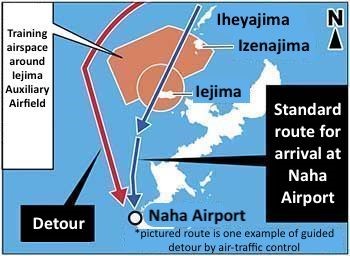Civilian aircraft not permitted in Iejima training airspace despite 1985 U.S.-Japan agreement

March 30, 2018 Ryukyu Shimpo
A 1985 agreement between the U.S. and Japanese governments gives civilian aircraft permission to enter U.S. military training airspace around Iejima at an altitude above 5000 feet (1524 meters). However on March 29 this year, the Marine Corps stated its understanding that passage of civilian aircraft is not permitted at all when the training airspace is in use by the U.S. military.
This is another indication that the U.S.-Japan Status of Forces Agreement (SOFA) is becoming merely a hollow shell.
There has been no mention of whether or not the agreement made in 1985 is valid. Domestic flights coming from outside Okinawa and arriving at Naha Airport have to detour around Iejima training airspace.
The U.S. Marine Corps stated that flights of civilian aircraft are not restricted when Iejima training airspace is not being used for military activities.
But it also expressed its understanding that if the airspace is in use, then passage cannot be permitted even above an altitude of 5000 feet and air-traffic controllers alert civilian aircraft in the vicinity that they must divert their courses.
At a House of Representatives Budget Committee meeting in March 1985, the director-general of the Civil Aviation Bureau of the Ministry of Transport (now the Ministry of Land, Infrastructure, Transport and Tourism) explained that they had reached an agreement with the U.S. that flights arriving in Naha were permitted through Iejima training airspace above an altitude of 5000 feet.
Up to this point civilian aircraft have passed through the Iejima training airspace safely above 5000 feet without hindering U.S. military activity, because the U.S. military normally conducts training at low altitudes in this airspace.
The Ministry of Transport explained in the National Diet that starting in April 1985 it would enforce this agreement.
According to aviation personnel, however, several years later flights were being restricted again.
Currently, entry into Iejima training airspace at up to an altitude of 15,000 feet is prohibited, so if the training area is in use, civilian aircraft coming to Naha from the north fly in accordance with air-traffic control’s instructions and detour all the way around this airspace. According to aviation personnel the government is normalizing this detour.
However, on March 28 an official from the Naha Airport Office of the Ministry of Land, Infrastructure, Transport and Tourism said, “Without the permission of the US and Japanese governments, I cannot say anything, including whether or not such an agreement exists.”
(English translation by T&CT and Erin Jones)
Previous Article:CV-22 Osprey set to deploy at Yokota Air Base also being used for night training in Okinawa, has a higher accident rate than the MV-22
Next Article:Tokashiki Village holds memorial service for mass suicide victims
[Similar Articles]
- U.S. training airspace around Okinawa expanded under guise of temporary use, impeding civil aviation
- Revised ordinance targets to impose penalty for kite flying and laser irradiation near U.S. military base
- MC-130J aircraft observed at low altitude after sixth U.S. military parachute drop training of 2021
- U.S. Navy helicopters violated minimum altitude during training outside military-use area
- After U.S. military aircraft flies at low altitude “clearly outside of regulation” Okinawa Governor’s chief of staff lodges protest over phone
 Webcam(Kokusai Street)
Webcam(Kokusai Street)


